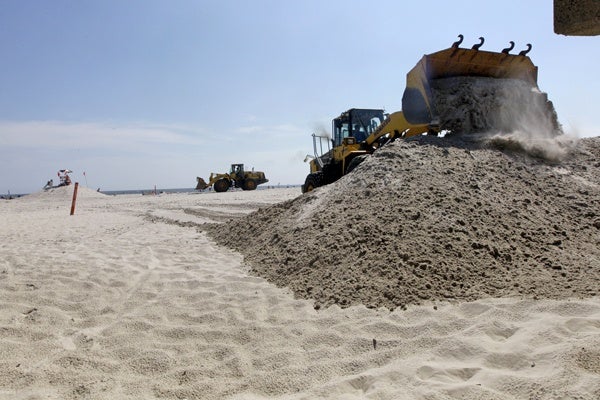How to build a better beach
-

-

-

(AP File Photo/Mary Altaffer)
-

-

Sitting by the ocean is one of summer’s simplest pleasures and, yet, many of New Jersey’s beaches are anything but simple.
Of the state’s 95 miles of developed Atlantic coastline, the U.S. Army Corps of Engineers has conducted “beach nourishment” projects on roughly 50 miles of shorelines and has plans for projects along 30 additional miles. They’ll spend much of the summer replenishing sand lost on these engineered beaches due to erosion during Superstorm Sandy.
“We’re going to spend close to $3 billion rebuilding the beaches and making them better,” Gov. Chris Christie said at a town-hall meeting last month.
Work is already underway in Ocean City, New Jersey, where the Army Corps has been adding sand to the beach since the early 1990s.
The nourishment process typically begins with an initial study to identify an area’s problems and potential solutions. If Congress decides to fund the project further, more detailed studies are done to arrive at a plan that specifies how much sand is needed and in what formation, including the height, width, and slope of any planned dunes. Construction companies bid on the project and the least expensive proposal is selected.
How to build a dune 101
“The first thing we need is a source of sand,” said Dwight Pakan, the project manager of the Ocean City site for the Army Corps.
Engineers try to match the new sand to grain of the native beach. Ocean City’s sand came from Great Egg Harbor Inlet.
Then a dredge, “basically a giant vacuum cleaner” sucks up the source sand, said Pakan. “It rotates and collects the sand with water at the same time and produces what’s called a surrey.”
The surrey is piped from the dredge to the beach under construction, where it’s shifted in giant metal baskets larger than an SUV.
“We had an issue on some previous beach fills, where unexploded ordinance were inadvertently pumped on the beach,” said Pakan.
The strained sand-water mixture is then set pumped a contained area of the beach to dry before bulldozers shape it into the height and width specified in the plans. Dunes are often planted with grasses to help hold the sand in place. Projects typically start at the northern end of a beach and make their way south, following the natural erosion path of the sand.
Provided there is funding available, the Army Corps will return every three years to maintain the dune and restore any sand lost to erosion.
“I think there’s a lot of public perception or misperception that we’re just throwing money into the ocean,” said Pakan. “Obviously we realize it’s going to erode, it’s designed to erode.”
He said these projects provide a reservoir of sand for nature to take off the beach during a storm, forming a sand bar offshore.
“It’s almost like nature tries to protect itself,” he said.
Large waves to break on the sandbar – instead of boardwalks, homes, and businesses. After a storm, some of that sand will naturally make its way back to the beach, but not all.
“Long Beach Island is probably the best illustration of where there was protection and where there wasn’t,” said Ed Voigt, the Army Corps’ chief of public and legislative affairs. “Where the projects were in place, those areas faired pretty well, and in some areas where there haven’t been projects yet, there was some pretty nasty damage.”
Dunes work best when built in long, unbroken stretches, which is why the Army Corps will only build projects in communities where the vast majority of ocean-front-property owners will allow the placement of sand on their land.
“It’s like building a wall to a castle with a big gaping hole in it,” said Lawrence Hajna, a spokesperson for the New Jersey Department of Environmental Protection, which partners with the Army Corp on beach replenishment projects. “The enemy pours through the gates if there’s breaches.”
WHYY is your source for fact-based, in-depth journalism and information. As a nonprofit organization, we rely on financial support from readers like you. Please give today.




